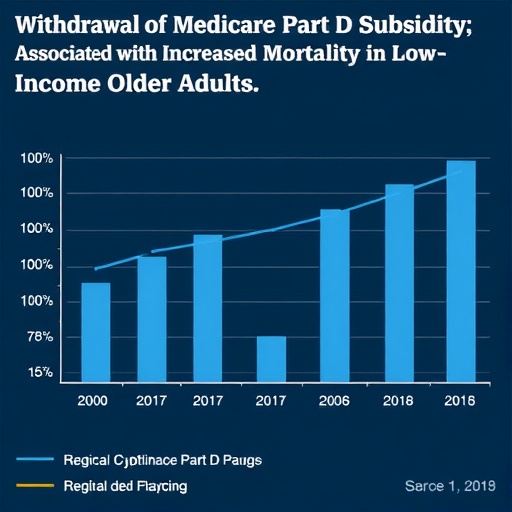
In a groundbreaking study published in the New England Journal of Medicine, researchers from the University of Pennsylvania Perelman School of Medicine and Harvard T.H. Chan School of Public Health have uncovered a critical link between the loss of Medicaid coverage and increased mortality among low-income Medicare beneficiaries. This discovery underscores the vital role of the Medicare Part D Low-Income Subsidy (LIS), a federally funded program designed to alleviate the financial barriers to essential medications for vulnerable populations. The researchers identified that termination of Medicaid—and consequently, the loss of the LIS subsidy—significantly raises the risk of death in these already at-risk groups, providing compelling evidence for policymakers on the importance of sustaining Medicaid eligibility for older adults.
Medicare Part D’s LIS program offers substantial financial relief to approximately 14.2 million low-income individuals by reducing prescription drug costs, which for many translates to access to potentially life-saving medications. The LIS benefit alone is valued around $6,200 annually, making it a cornerstone for preventing medication non-adherence due to cost. Among the beneficiaries affected are the roughly 12.5 million dual eligibles—individuals enrolled in both Medicare and Medicaid—who are automatically qualified for this subsidy. When Medicaid coverage lapses, however, these low-income seniors often lose the LIS benefit, creating a dangerous gap in their medication coverage.
The study took advantage of a natural experiment resulting from Medicaid program rules that trigger LIS benefits loss at specific times contingent on when Medicaid coverage ends intra-year. Nearly one million low-income Medicare beneficiaries who experienced loss of Medicaid were divided into two cohorts: those losing Medicaid in the first half of the year and hence LIS benefits 7 to 12 months earlier, versus those losing Medicaid in the latter half who retained LIS for a longer 13 to 18 month period. By comparing mortality rates between these groups during the period when the LIS benefit was lost for one group but retained by the other, the researchers elucidated the true impact of losing medication subsidies on health outcomes.
Remarkably, mortality among individuals who lost the LIS earlier was 4% higher than those who maintained the subsidy for longer. Over the total study period, this translated into the excess death of over 2,900 people, a staggering public health toll attributable to disruptions in drug affordability. The effect was strikingly pronounced in patient subgroups requiring more specialized and costly medication regimens, such as people living with HIV who rely on antiretroviral therapy. In this subgroup, mortality rates surged by 22%, highlighting the heightened vulnerability of medically complex patients to policy and programmatic shifts.
Compounding this problem, the study noted that more than half of those who lost Medicaid later regained it within 12 months, indicating systemic churn and administrative challenges that result in erroneous disenrollment. These interrupted cycles of coverage jeopardize continuous medication access, increasing clinical instability and mortality risks. This finding challenges the notion that loss of coverage reflects true status changes, instead suggesting that many vulnerable seniors are wrongfully dropped from Medicaid and consequently lose LIS benefits to their detriment.
The study’s lead author, Eric T. Roberts, PhD, emphasized the direct connection between Medicaid retention and life-saving medication access: “When Medicare beneficiaries lose Medicaid, which happens to over 900,000 people annually, they simultaneously lose the LIS, undermining their ability to afford critical medicines.” This statement illuminates the cascading nature of policy impacts on individual health and drives home the urgent need for reforms that prioritize continuity in coverage.
Senior author José F. Figueroa, MD, MPH, further stresses the importance of policy safeguards: “Helping low-income Medicare beneficiaries stay enrolled in Medicaid and retain the LIS is more than an administrative goal—it is a necessary intervention to prevent avoidable deaths and safeguard health equity.” This research aligns with broader health equity frameworks by highlighting how systemic vulnerabilities disproportionately endanger older, poorer adults who depend on public benefit programs for survival.
As policymakers debate proposed changes to the Medicaid program amid ongoing political and fiscal pressures, this study serves as a cautionary tale. Interruptions in Medicaid coverage risk eroding the gains achieved through decades of public health investment, particularly in medication adherence that underpins management of chronic diseases in older adults. Without safeguards to prevent losses in the LIS subsidy, the health consequences, including excess mortality, are likely to worsen.
Technically, the study harnessed robust epidemiological methods, utilizing quasi-experimental design exploiting Medicaid administrative timing to infer causal relationships between LIS discontinuation and health outcomes. This approach circumvents confounding factors typical in observational studies and strengthens confidence that the mortality increases observed are indeed attributable to loss of medication affordability rather than underlying health differences.
Beyond mortality, the findings have major implications for health systems aiming to reduce avoidable hospitalizations and healthcare costs related to medication non-adherence. Ensuring uninterrupted access to affordable prescription drugs not only saves lives but may also decrease the burden on emergency and inpatient services, ultimately benefiting the healthcare economy.
Funding and support for this research came from prestigious sources including the National Institute on Aging, the Agency for Healthcare Research and Quality, and Arnold Ventures, reflecting the critical priority this issue holds in public health research agendas. Such investment signals growing recognition that social determinants like program eligibility are fundamental drivers of health outcomes and warrant rigorous scientific scrutiny.
In conclusion, this landmark study elucidates the perils of Medicaid disenrollment for low-income Medicare beneficiaries, delineating a direct, quantifiable relationship between policy lapses and mortality. The findings advocate fiercely for strategies that enhance Medicaid retention and preserve LIS benefits, thereby safeguarding medication access and improving survival in America’s most vulnerable older adults. As the nation faces demographic shifts and rising demand for chronic disease management, the lessons from this research must inform future health policy to promote equitable, life-saving care.
Subject of Research: Impact of Medicaid coverage loss and Medicare Part D Low-Income Subsidy discontinuation on mortality among low-income Medicare beneficiaries.
Article Title: Loss of Medicare Low-Income Subsidy Associated with Increased Mortality in Low-Income Medicare Beneficiaries
News Publication Date: June 2024
Web References: https://www.nejm.org/doi/full/10.1056/NEJMsa2414435
References: Funding sources include National Institute on Aging (R01AG076437; R01AG081151; RF1AG088640; T32AG000037), Agency for Healthcare Research and Quality (R01HS029453), and Arnold Venture.
Keywords: Health equity, Medicaid, Medicare, Low-Income Subsidy, Prescription drug affordability, Mortality, Chronic disease management, Public health policy
Tags: dual eligibles in healthcarefinancial barriers to medicationsimpact of Medicaid terminationimportance of sustaining Medicaid eligibilitylow-income Medicare beneficiariesMedicaid coverage and mortalityMedicare Part D Low-Income Subsidymedication non-adherence issuesolder adults health risksprescription drug cost reliefpublic health policy implicationsvulnerable populations in healthcare





